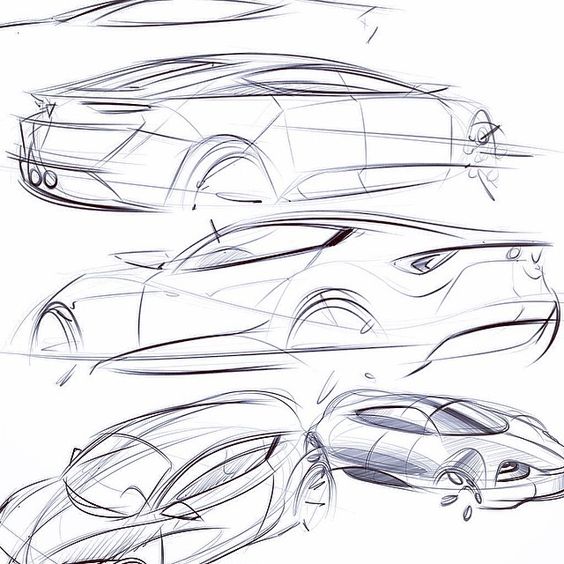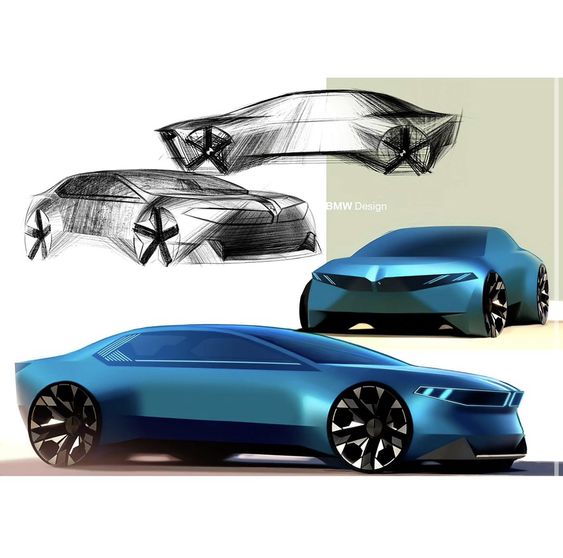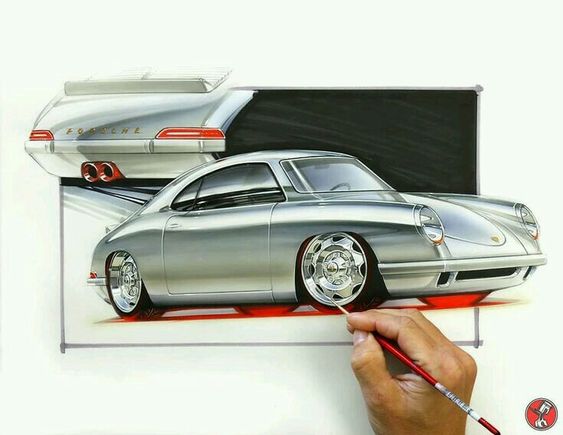

Sketching cars is an exciting activity for both beginners and experienced artists. Creating unique and innovative car designs can spark creativity and lead to impressive artworks. This article will show some of the best ideas to get started with car sketches.
Whether you want to draw sleek sports cars or rugged off-road vehicles, these ideas will provide a variety of fun and engaging sketching options. These concepts are simple to follow and can help anyone improve their sketching skills.
1) Concept Sports Car


A concept sports car represents the future of automotive design. These cars often feature sleek lines, advanced materials, and innovative technology. Designers explore bold, aerodynamic shapes that hint at high performance and luxury.
The concept sports car’s interior is just as impressive. Often, it incorporates cutting-edge interfaces, touch screens, and ergonomic seats. These design elements aim to enhance both comfort and driving experience.
Incorporating unique lighting, such as LED strips, is common in concept sports cars. These lights can be used to highlight the car’s contours and add a modern, high-tech look. They often also include sustainable materials, embracing eco-friendly concepts.
These cars are not just about aesthetics. Under the hood, they often pack powerful engines or futuristic electric powertrains. This blend of form and function showcases the potential direction of future sports cars.
2) Retro Muscle Car


The Retro Muscle Car sketch idea takes inspiration from the classic American muscle cars of the 1960s and 70s. Design should focus on bold lines and aggressive shapes. The car should have a wide stance and a low profile.
Details like a prominent grille and hood scoops are essential. Wheels should be large and chrome-plated, adding to the tough look. The rear should feature a simple but striking design with dual exhausts.
Consider using bright colors like red, blue, or black for the body. Stripes or racing decals could enhance its sporty appeal. Features such as round headlights and rectangular taillights complete the retro vibe.
3) Futuristic Electric Vehicle


A futuristic electric vehicle puts technology and eco-friendly design front and center. It showcases sleek, aerodynamic lines that minimize air resistance and enhance efficiency.
The design includes large, touch-screen dashboards and AI integration for a smarter driving experience. These cars often come with advanced safety features, including automatic braking and lane-keeping systems.
Innovative battery technology allows for longer driving ranges. The exterior may feature LED lights, giving the car a modern and stylish look. Self-driving capabilities are another key element, adding to the vehicle’s futuristic appeal.
The materials used are often lightweight and sustainable, such as carbon fiber or recycled materials. This not only reduces the car’s weight but also its carbon footprint.
Interior spaces are designed with comfort and functionality in mind. Spacious seating arrangements, virtual reality entertainment systems, and customizable lighting are commonly included.
Overall, these vehicles represent the future of transportation, combining cutting-edge technology with eco-friendly practices.
4) Classic Convertible


The Classic Convertible exudes timeless elegance. Its design features smooth, flowing lines that evoke a sense of nostalgia. With its roof down, the car offers a thrilling open-air driving experience.
The front grille typically showcases chrome accents. Sleek headlights and rounded fenders add to its vintage charm. Most classic convertibles incorporate a two-door structure, emphasizing a streamlined look.
Inside, these cars often feature leather seats and wood trim. The interiors are both luxurious and comfortable. Every detail, from the steering wheel to the dashboard, reflects meticulous craftsmanship.
Sketching a Classic Convertible involves capturing its graceful curves. Focus on proportions to keep the design true to its heritage. It’s essential to highlight unique features, like the retractable roof mechanism.
Including intricate details like the door handles and side mirrors can enhance the sketch. Pay attention to the wheels, as vintage rims often have distinct designs. Adding shadows and lighting can help bring the sketch to life.
A well-drawn Classic Convertible sketch not only represents the car’s elegance but also its enduring appeal. It’s a beautiful blend of form and function that continues to captivate car enthusiasts.
5) Aerodynamic Sedan


The Aerodynamic Sedan focuses on sleek lines and smooth curves. Its design reduces air resistance, making it efficient and fast. The car’s low profile helps it glide through the wind with ease.
The roofline slopes gently to improve aerodynamics. The front of the sedan features a streamlined shape, which guides air over the car smoothly.
The sides of the car are smooth with minimal protrusions. This reduces drag and enhances fuel efficiency. The sedan’s rear is designed to minimize turbulence, further improving its aerodynamic performance.
The wheels are partially covered to reduce air resistance. The car also has a flat underbody to prevent air from getting trapped underneath. These features contribute to a more efficient ride.
Designers pay close attention to every detail of the Aerodynamic Sedan. Every curve and angle is tested to ensure it helps the car move through air efficiently.
Advanced simulations are used to perfect the design before any physical model is built. This helps to make the car not only stylish but also highly functional.
6) Luxury SUV


Luxury SUVs combine advanced technology with high-end materials. Designers focus on creating a spacious interior with comfortable seating and premium features. Leather seats, wood trims, and digital displays are common.
From the outside, a luxury SUV should have a sleek and sophisticated look. Alloy wheels, LED headlights, and aerodynamic shapes help achieve this. Large grilles and bold lines often add to the elegant appearance.
Safety is a key element. High-end SUVs usually include features like adaptive cruise control, lane-keeping assist, and automatic emergency braking. These systems improve the driving experience.
The powertrain in a luxury SUV is often robust. Many models feature V6 or V8 engines, providing strong performance and smooth acceleration. Hybrid options are also increasingly popular, offering better fuel efficiency.
Customizable settings for driver comfort and seating positions are important. Heated and ventilated seats, panoramic sunroofs, and advanced climate control systems offer convenience. These features cater to the diverse needs of drivers and passengers.
An impressive sound system enhances the driving experience. Brands like Bose or Bang & Olufsen often provide top-tier audio quality. Integration with smartphones and smart assistants allows for easy control of music and navigation.
7) Compact City Car


The compact city car is designed for urban environments. It features a small size, making parking and maneuvering through tight spaces easy. This type of car often has a boxy shape to maximize interior space while keeping the exterior dimensions minimal.
Small wheels and short overhangs are common. These features help with tight turns and enhance the agility of the vehicle. Simplicity in design is also typical, with smooth lines and minimalistic elements.
Inside, a compact city car usually has a practical layout. Seating for four is common, with foldable rear seats to increase cargo space. The dashboard is simple, with easy-to-read displays and user-friendly controls.
Electric versions of the compact city car are becoming more popular. They produce zero emissions, making them environmentally friendly. These electric models often have a modern, futuristic look, with sleek lines and innovative lighting designs.
Color choices for compact city cars tend to be bright and bold. Shades like red, blue, and yellow can make the car stand out in city traffic. Some models may also offer two-tone paint options for a more customized appearance.
Safety is also a priority in compact city cars. Features such as airbags, anti-lock brakes, and advanced driver-assistance systems are often included. This ensures that even in a small package, the car offers substantial protection.
8) Off-Road Adventure Vehicle


An Off-Road Adventure Vehicle is designed to handle rough terrains and long journeys. It features high ground clearance and durable tires that can tackle rocky paths and muddy trails.
The design includes a strong frame to withstand harsh conditions. A powerful engine helps the vehicle climb steep hills and navigate tough landscapes effortlessly.
Inside, the vehicle offers ample storage space for gear and supplies. It often comes with advanced navigation systems to ensure safety and direction in remote areas.
Comfort is also crucial. Seats are designed to support long hours of driving on uneven surfaces. Climate control keeps the interior comfortable, regardless of the outside weather.
Exterior features like roof racks and mounted lights are practical additions for adventure trips. Skid plates and reinforced bumpers protect the vehicle from damage during off-road excursions.
Overall, this type of vehicle is built for those who love exploring the wild and need a reliable means of transportation to do so.
9) Streamlined Coupe


The streamlined coupe is all about smooth lines and sleek design. It focuses on reducing air resistance to improve speed and fuel efficiency.
Designers should aim for a low, aggressive stance. The hood should be long and sloped, flowing into a compact rear end.
Adding sharp headlights and a thin grille can give it a modern look. The windows should be narrow to enhance the aerodynamic shape.
Consider using materials like carbon fiber for a lighter body. This can help achieve a better power-to-weight ratio.
Wheels should be tucked in slightly, adding to the streamlined appearance. Rearview mirrors can be replaced with cameras to further reduce drag.
Pay attention to the details, such as hidden door handles and flush surfaces. These small elements contribute to the overall sleekness.
Inside, keep the cabin minimalist and driver-focused. Use high-quality materials for a luxurious feel.
10) Custom Hot Rod


A custom hot rod is a favorite among car enthusiasts due to its unique design and powerful performance. A classic hot rod typically features a stripped-down body, a large engine, and custom paint jobs.
This sketch should highlight the sleek lines and bold features that make hot rods stand out. Including elements like an exposed engine or stylish fenders can emphasize its high-performance nature.
By adding custom details, such as unique wheel designs or special decals, the sketch can capture the individuality of a custom hot rod. The goal is to create a design that feels both nostalgic and modern.
Don’t forget to showcase the distinctive front grille and custom interiors. These details can give the sketch that extra wow factor, making it a standout design in any collection.
Essentials of Car Sketching


Creating car sketches requires a good grasp of proportions, perspective, and basic shapes. Each element plays a crucial role in crafting realistic and attractive car designs.
Understanding Proportions
Car proportions are key to any good sketch. They determine the car’s overall balance and aesthetic appeal. Start by dividing the car into equal parts. The vehicle can be broken down into three main sections: the front, the middle, and the back. Each section has its own unique features.
Front Section:
- Headlights
- Grille
- Hood
Middle Section:
- Cabin
- Roof
- Windows
Back Section:
- Tail lights
- Trunk
- Rear bumper
Practice sketching each part separately. This helps in understanding the unique proportions of different car models.
Mastering Perspective
Perspective adds depth to a sketch. A car sketched in the right perspective looks realistic. Practice drawing cars from different angles: front, side, rear, and three-quarter views.
-
- Simple for beginners
- Suits side views
Two-Point Perspective:
- Adds depth
- Ideal for three-quarter and front views
Practice is key. Start with simple shapes like boxes and cylinders to learn how they change with different angles. Gradually apply this knowledge to car parts and full car designs.
Basic Shapes and Forms
Cars consist of basic shapes. Understanding these shapes makes sketching easier. Most cars combine circles, rectangles, and curved lines.
Steps to follow:
- Start with a simple rectangle for the body.
- Add circles for wheels.
- Refine with curves for fenders, windows, and other details.
Additional Tips:
- Use light, thin lines for initial shapes.
- Gradually add details and depth.
- Erase unnecessary lines once the sketch takes shape.
These basics help in creating a strong foundation for any car sketch. Combining basic shapes with accurate proportions and perspective leads to realistic and appealing car designs.
Advanced Techniques
When sketching cars, using advanced techniques can make designs look more realistic and professional. Key areas include shading, textures, and detailing to bring out the finer aspects of the car design.
Shading and Textures
Shading helps to create depth and dimension in car sketches. Artists should start with light shading and gradually build up darker shades. Soft pencils are ideal for smooth transitions, while harder pencils can define sharper edges.
Textures, such as metal, glass, and rubber, add realism. Artists can use cross-hatching for metal surfaces, stippling for a rubbery look, and smooth gradients for glass. Layering these techniques makes the sketch more dynamic.
Detailing and Refinement
Detailing focuses on the smaller parts of the car, like headlights, grilles, and rims. Precision is key here. Using fine-tip pens can outline these details sharply, ensuring they stand out.
Refinement involves going over the sketch to clean up lines and enhance clarity. Artists should revisit areas that look rough or unfinished. Erasers can correct mistakes, while white pencils can highlight and bring out finer details for a polished look.
Presentation and Final Touches
After sketching, adding the final touches will make the car design stand out. They should start by refining the lines to ensure all aspects are clear and precise. Small details matter. Adding features like door handles, headlights, and mirrors can bring the sketch to life.
Shading and Coloring
Shading adds depth to the sketch. They should use light and shadow to highlight curves and angles. Colored pencils or digital tools can help. Use colors to differentiate materials and show various parts of the car clearly.
Polishing the Drawing
They should make sure the sketch is clean. Erase any stray marks and smudges. If working on paper, using a fixative spray can prevent smudges. For digital sketches, tweaking the brightness and contrast can enhance the final look.
Displaying the Sketch
The presentation of the sketch is just as important. Before finalizing, they should consider using a simple background to keep the focus on the car. A high-quality scan or photo can be used if it’s a physical drawing. Digital images should be saved in a high-resolution format.
Frequently Asked Questions
Car sketching can be a fun hobby or a professional skill. Here are answers to common questions to help you get started and improve your technique.
What are some basic car sketches for beginners?
Beginners can start with simple sketches like a basic sedan or a compact hatchback. These sketches help with understanding proportions and shapes. Focus on drawing clean lines and maintaining symmetry.
What steps should I follow to draw a realistic car?
Begin with basic shapes to outline the car’s body. Add details like windows, wheels, and headlights in stages. Pay attention to proportions and perspective. Clean up your lines and shade the sketch to add depth and dimension.
How can I improve my car sketching techniques?
Practice regularly to refine your skills. Study real cars and other sketches to understand different styles. Experiment with shading and highlighting. Getting feedback from more experienced artists can also help you learn and improve.
What are some tips for drawing creative car designs?
Think outside the box and combine elements from different types of cars. Look at modern and futuristic designs for inspiration. Try to sketch unique features that make your car stand out, like unusual silhouettes or innovative details.
What materials do I need to start sketching cars?
Basic materials include pencils, pens, erasers, and sketching paper. As you advance, you can invest in markers and colored pencils for shading. Some artists also use digital tools like tablets and styluses for more detailed work.
Can you provide guidance on sketching the perspective of a sports car?
Start with a side view to get the car’s profile right. Then, add perspective by drawing angled views. Focus on the car’s dynamic lines and curves. Pay special attention to how the wheels align and how light interacts with the car’s surface.
- 542shares
- Facebook0
- Pinterest542
- Twitter0


